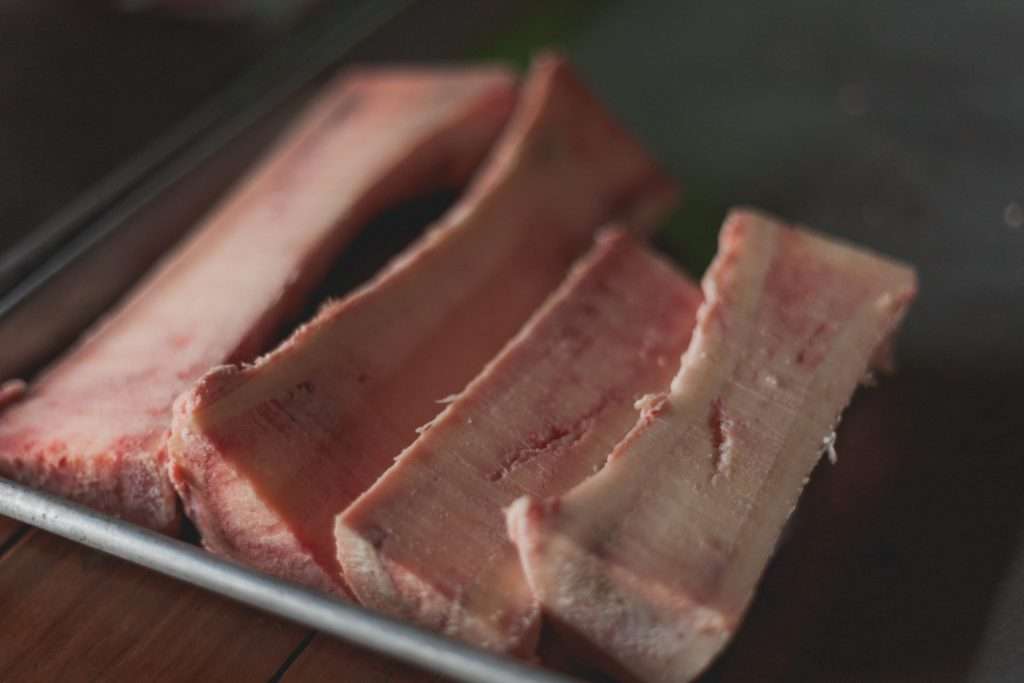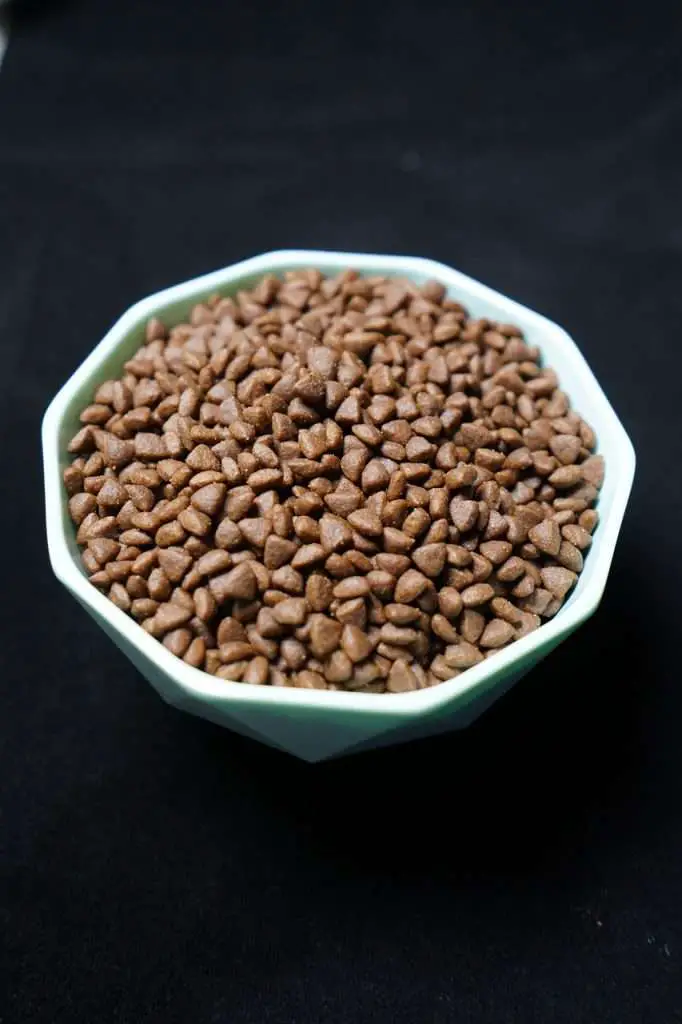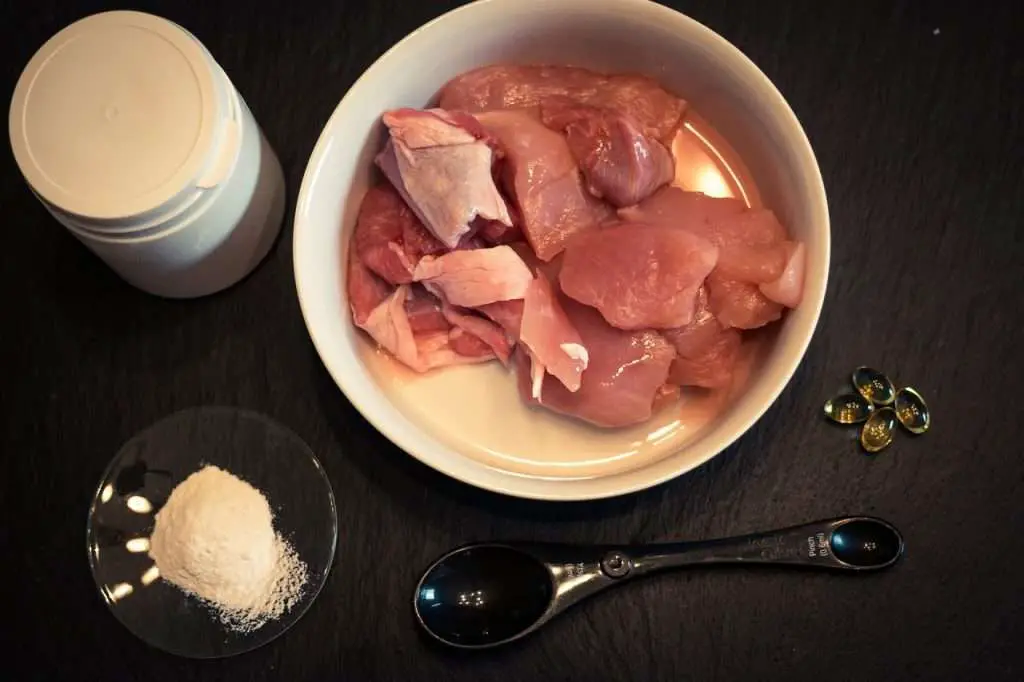Dogue De Bordeaux Diet: What to feed a Dogue de Bordeaux?

The Dogue de Bordeaux diet has been scrutinised over the past few years. Owners have become more conscious of the health impacts that certain foods have on the wellbeing of their dogs. Especially when considering the already extensive list of health conditions that most Dogue de Bordeaux’s are genetically predisposed to.
This is especially the case for many larger mastiff breeds like the Dogue de Bordeaux (A.K.A The French Mastiff), which is known for piling on the pounds. Many owners in this family are advocating for higher quality ingredients, adequate protein bio availability, healthier fats and good vitamin and mineral content.
This has led to the adoption of raw feeding (BARF – biologically appropriate raw foods), higher quality cooked & human grade ingredients such as butternut box and improved quality kibble that increases the inclusion of key vitamins & minerals whilst also limiting potentially inflammatory elements such as excessive grains and modified starches.
But that’s not all. The pet care market has also opened itself up to supplements, aimed at targeting bone and joint health, brain function and general a multi-vitamin approach, all wrapped up in a yummy chew.
However, getting the food right for the Dogue de Bordeaux diet isn’t the only factor to take into account. Owners also need to be aware of the right quantities (puppy vs adult), taste & stimulation, all whilst keeping an eye on ever spiralling costs on things like chews, treats & bones.
Worry not, our Dogue de Bordeaux diet guide aims to take you through this by demonstrating the pros & cons for the different options whilst demonstrating the realistic costs.
Let’s start by laying out the different Dogue de Bordeaux dieting options:
Raw Diet For The Dogue de Bordeaux
The raw diet has become a trendy movement in the dog world, with many start-up dog food companies jumping in on the opportunity. That said, “feeding raw” is something that has existed for many years as intuitive owners have always known the benefits of delivering high nutrient dense foods to their dogs.
The raw dog food diet can be broken down into two succinct approaches:
- The removal of overly processed ingredients (including – starches, preservatives, grains, sugars)
- The addition of single ingredient items such as raw muscle meat, organs, bone marrow, occasional fish, and dog-safe vegetables.
The diet may seem extreme to many and certainly has its critics, however it’s very hard to argue with the nutrient density delivered in each meal compared to generic, everyday dog food found on the supermarket shelf.
Advocates for this approach to the Dogue de Bordeaux diet believe that the dog’s stomach is not designed to digest and ferment excess carbohydrate (typically found in kibble). They believe that overly relying on kibble throughout the dog’s life can result in a weakened immune system, inflammation in the joints and metabolic issues such as glucose spikes. Many owners of the French Mastiff have adopted this approach as a way of trying to combat their well documented health concerns.
Other reported benefits that owners report anecdotally are an improvement in digestive issues and gut biome, obesity, mobility, energy, skin complaints and an overall improvement in coat condition.
When it comes to the raw diet for the Dogue de Bordeaux, many owners across the board appear to choose a ratio of 70% muscle meat, 10% organs, 10% bone product and 10% dog friendly vegetables.
Owners have two options when adopting the raw feeding approach:
- A subscription box which prepares the mix ratios into convenient frozen meal packets and sends them to you weekly or monthly.
- A DIY approach where owners can buy the ingredients at a grocery store or farmers market and batch the meals throughout the week. This gives owners ultimate control on the types of ingredients going into the meals, which may be helpful if you have a fussy eater. We advise that owners try to source high quality ingredients, organic & grass fed where possible to ensure the highest qualities.
If you choose to go down the DIY route, some good ingredients to include are:
- Turkey necks
- Lamb necks
- Raw carcasses (chicken, turkey, duck)
- Chicken feet
- Venison fillet
- Raw brisket bones
- Sardines, mackerel, salmon, tuna
- Beef or lamb hearts, liver, kidneys

Are There Negatives To The Raw Diet For Dogue de Bordeaux?
One of the very obvious drawbacks to this approach is the cost of feeding a raw diet. The caloric intake of a large Mastiff breed like the French Mastiff is high. The dog grows fast, has a lot of muscle and therefore requires a diet that can accommodate. Some owners estimate that they spend north of £1000 when feeding their Mastiffs on a premium raw diet, that’s approximately £20 a week. Although that may be on the higher end, owners can be wiser with their purchases, opting for cheaper cuts of meat. Striking up a good relationship with your local butcher or farmer is also another way of bringing costs down.
The other cost is the drain on time and convenience. This is where a raw dog food subscription service can be worthwhile. Companies such as Nature’s Raw have different boxes to choose from, with their large box offering 30 meals for £110.50. Keep an eye out for coupons as many of these companies may offer discounts and trials. Ultimately, this can be a more expensive way of feeding your Dogue de Bordeaux. It may require some experimenting with in-order to get the costs down.
Finally, it must be stated that many vets still do not fully approve of this way of feeding. Concerns around the animal product sourcing, hygiene and harmful pathogens that come with raw feeding are common complaints. Although some suggest gentle searing of the food can help reduce some of these concerns.
It’s still fairly early in this trend. As more businesses enter the raw dog food market, we will likely see more regulation and standards that ensure the wellbeing of owners and dogs alike.
Pros & Cons of Raw Diet For The Dogue de Bordeaux
| Positives | Negatives |
| Transparency on ingredients | Costs |
| Nutrient density | Not fully endorsed by vets |
| Elimination of nasties | Time |
| Flexibility with ingredients |
Homemade Fresh “Human Grade” Diet For Your Dogue de Bordeaux
What’s fresh dog food?
You might be thinking, Isn’t that just raw? No. Fresh dog food nowadays refers to human quality meat and vegetables which are gently cooked. In the previous section, we mentioned vets’ concerns over hygiene and harmful pathogens. The “Fresh dog food” trend is a move to help combat those concerns.
Start-ups like Butternut Box are leading the way on this trend in the UK. They have a “gently cooking, no nasty, no mystery meats, no kibble” approach to dog food. With a large range of meals to choose from, it’s also good for fussy eaters. That said, the reliance on muscle meat may limit foods such as organs and bone matter from being included. In turn this may limit nutrients and satisfaction from your dog’s perspective. Although, let’s face it. Satisfaction will still be a lot higher when compared to many other mainstream options.
That said, many owners may choose to simply adopt this approach themselves. Simply buying the meat and vegetables ingredients in the supermarket and then preparing meal batches throughout the week. This can help control the freshness and quality of ingredients being fed.
In terms of costs, Fresh food feeding can be similar to that of the raw diet. Subscription box prices vary. Entering the information for a Dogue de Bordeaux, my weekly costs come to around £25-30. Whereas if I were to source the ingredients myself, I could realistically get this cost down to around £20, maybe less with cheaper cuts of meat and a good relationship with my local butcher.
| Positives | Negatives |
| Transparency on ingredients | Costs |
| High quality ingredients | Over-reliance on muscle meat |
| Flexibility with ingredients | Time lost when self sourcing |
| Time saver when choosing subscription |
Kibble For Your Dogue de Bordeaux
Kibble has gotten a bad name for itself in many dog ownership communities. Issues occur with kibble when owners overly rely on it as a food source throughout the dog’s life. That said, not all kibble is created equal. Like anything, there are high quality options and low quality options, and prices do not always fully reflect the quality, it’s more about knowing what to look out for when reading the ingredients list.
Many brands of kibble will overly rely on cheap inputs to keep costs down. This can lead to too much processed ingredients such as:
- Modified starches
- Preservatives & Additives
- Artificial flavourings
- Wheat, grain & gluten

Owners should look for brands that have a cleaner list of ingredients. Many newer brands have come onto the market which cater for this. They have been able to provide a good array of freeze dried meat & fish based products, which a mixture of vegetable matter to help supplement. They have also removed the heavy use of grain material, plus any unnecessary additives.
Kibble can be a great tool to help bring the costs down and thus can be great for supplementing one of the other dieting approaches (raw & fresh food). Kibble is also recommended for puppies, allowing their teeth and gums to develop by taking on more solid foods that aren’t overly sensitive for their stomachs.
Prices for kibble vary dramatically. Low grade kibble will likely cost £15-20 for 15kg. Whereas higher grade kibble (real ingredients) will cost around £40-50 for 15kg. That is obviously a fair amount of discrepancy.
| Positives | Negatives |
| Recommended in puppyhood | Transparency on ingredients |
| Convenient | Can contain nasties |
| Large range in flavours | High grade kibble is moderately expensive |
Wet Food For Dogue de Bordeaux
Very similar to kibble, wet food comes in ranges of quality and price discrepancy and is commonly found in supermarkets next to the dry food section. Lower grade wet-foods can contain nasties such as an over-reliance on preservatives, additives, hidden sugars and inflammatory cereals used to bulk up the perceived offering.
We recommend opting for a higher grade wet food, being sure to check the ingredients list isn’t as long as your arm and reads like the period table. There are so many new businesses on the market that offer higher grade wet food alternatives such as Bella and Duke, Applaws and even crossovers such as Butternut Box essentially offer raw dog food. These typically come in pouches or tins.
Price differences are huge so we recommend you do your own independent research on the best options for your Dogue de Bordeaux’s diet.
| Positives | Negatives |
| Convenient | Transparency on ingredients |
| Large range in flavours | Can contain nasties |
| High grade wet food is moderately expensive |
Dogue De Bordeaux Eating Habits
Some remark that the French Mastiff isn’t all that food driven and instead gets its sense of satisfaction through companionship and protecting its owners and family. From experience, the second part seems especially true, but my Dogue de Bordeaux was also exceptionally food driven… And I’m sure those droopy soppy eyes and drooly sloppy cheeks everytime you open the fridge may also indicate that yours also loves its food.
One thing to watch out for with this breed is “bloat” which is common in many Mastiff breeds. Bloat occurs when the Dogue de Bordeaux eats large meals too fast, it can lead to gastric torsion and become a serious ongoing issue if not handled correctly.
In order to combat bloat, we recommend different tactics such as:
- Feeding smaller quantities but more often (equalling their recommended daily caloric intake).
- Include harder to chew elements such as ice cubes to slow their eating down. This may be where raw diet enthusiasts claim bone material can be good as it encourages checking and breaking down.
- Use a bowl stand to change the posture of their neck, so that swallowing is easier.
- Ensure fresh water is available at all times of the day.
How much to feed your Dogue de Bordeaux
How much you feed your Dogue de Bordeaux really depends on their age, size, gender and other aspects such as metabolism. Vigilant owners should look to keep an eye on ensuring their dog is at a healthy weight, in good condition and has appropriate energy levels.
Throughout early puppyhood, the Dogue de Bordeaux will rely on milk from its mother until around week 3-4, sometimes up to 8 weeks. After this period, owners should look to transition their puppies onto solids. Firstly, this can be achieved by using a high-quality dry food, soaking it in water to get a porridge-like consistency.
As your puppies teeth and gums start to develop, you can start to increase the solidity of the foods you feed it, finally adding in wet food when your puppy is ready. As your puppy hits the 12 month phase, its caloric intake needs to be around the 1800-1900 mark.
Caloric intake of the Dogue de Bordeaux in adulthood should aim for around 2800. Finally, in the senior years calories are typically reduced further. However, this may not always be the case.
Once you decide on your Dogue de Bordeaux diet, whether it’s raw, fresh and home cooked, or a mixture of all. You need to ensure its caloric requirements are met.
Dogue de Bordeaux Feeding Chat
| Dogue de Bordeaux Age | Amount of Food (Grams) | Feed Type |
| 0 – 4 Weeks | Mothers Milk | |
| 5 – 12 Weeks | 1440 – 2400 | Weaning Period – Mix dry food with water |
| 3 months – 12 months | 1440 – 2400 | Dry kibble with wet food added later |
| 12 months – 24 months | 1440 – 2400 | At owners discretion |
| Adult | 960 – 1200 | At owners discretion |
| Senior | 720 – 960 | At owners discretion |
Supplements for Dogue de Bordeaux
Supplements can have various benefits for dogs as they age, especially for breeds such as the Dogue de Bordeaux due to its list of health conditions.
Good supplements can aid in digestion and uptake of nutrients from food, improve skin and joint conditions, alongside a healthier looking coat. Alternatively, some supplements can help maintain energy levels as well as cognitive functioning.

We recommend speaking to your vet before investing in supplements. However, common supplements for this breed will include:
- Glucosamine & chondroitin (for joints)
- Fish oils (joints, heart health, brain function)
- Probiotics (gut health)
- Antioxidants
Why isn’t your Dogue de Bordeaux eating?
As mentioned earlier, the Dogue de Bordeaux isn’t typically a fussy eater. However, dogs do go off their food from time to time which can concern many loving owners.
As an owner of this marvellous breed, owners should keep an eye on their sensitive nature as there are multiple reasons as to why the Dogue de Bordeaux might not be eating.
Reasons may include:
- Under the weather
- Gastro or digestion problem (sometimes you’ll see your dog eating grass to remedy this)
- Worm or bacterial infection
- Dental concerns
- Loss of vision or hearing
- Urinary tract infection
- Has gone off a particular type of food
- Anxiety
- Overheated
- Change in environment
If you suspect any of the above and the issue does not resolve itself, then we highly suggest you call your local vet and have them seen to.
And that concludes our guide to the Dogue de Bordeaux diet. We hope you found this informative, if you valued this post or want to share feedback then please subscribe to our newsletter.